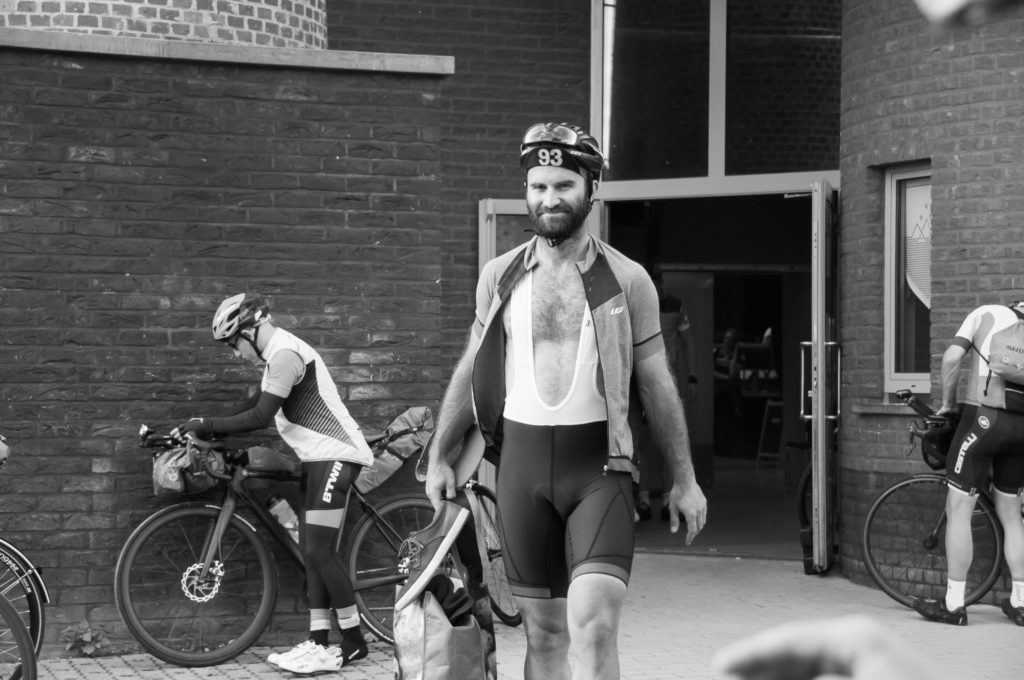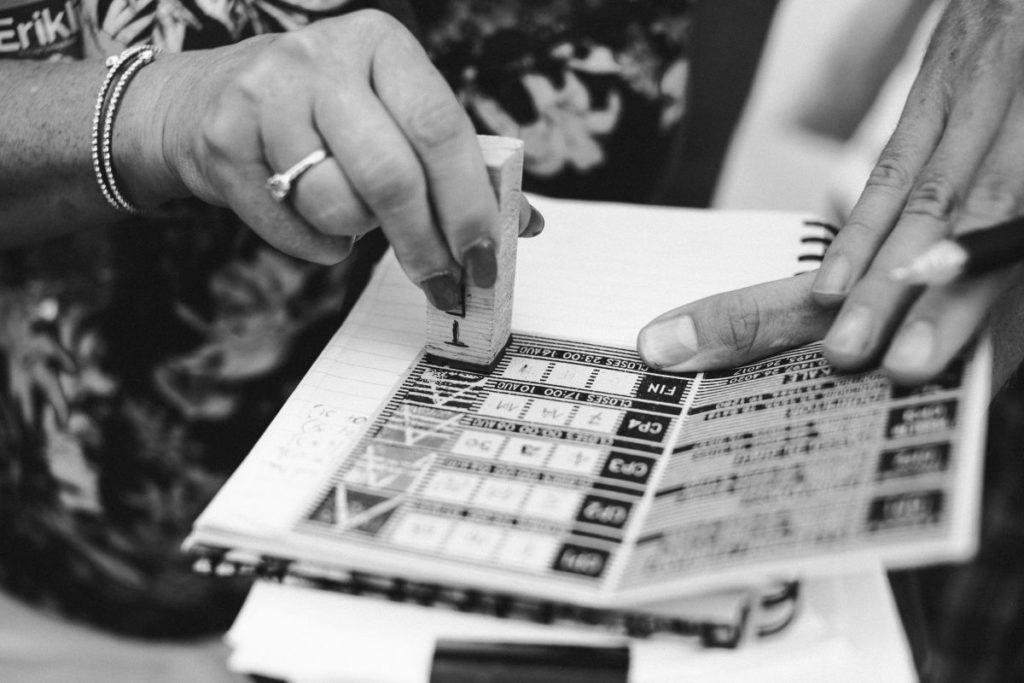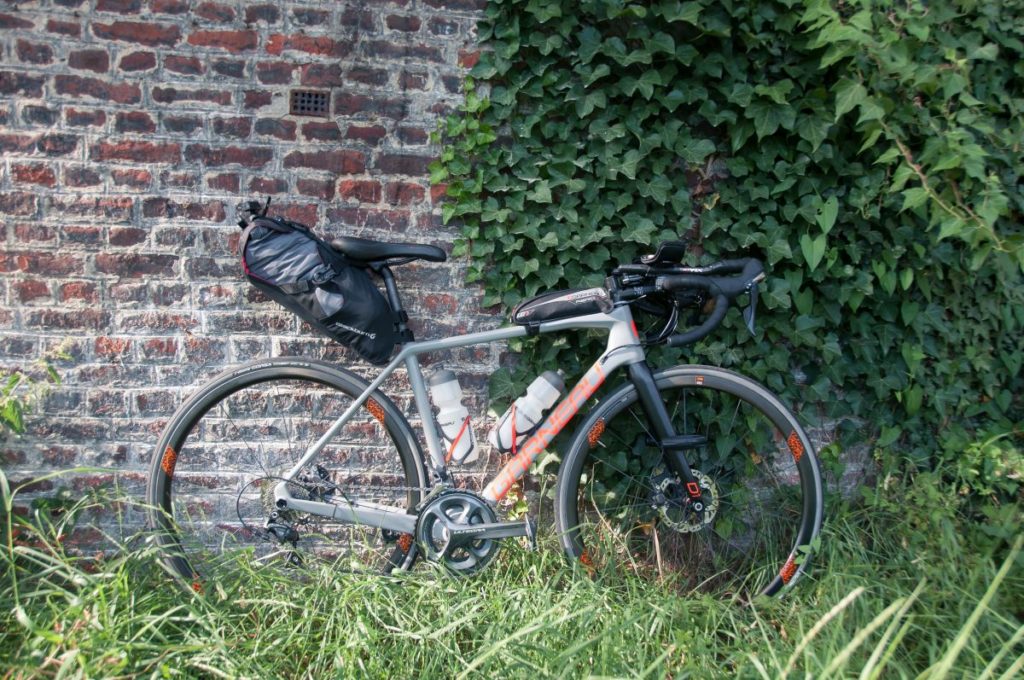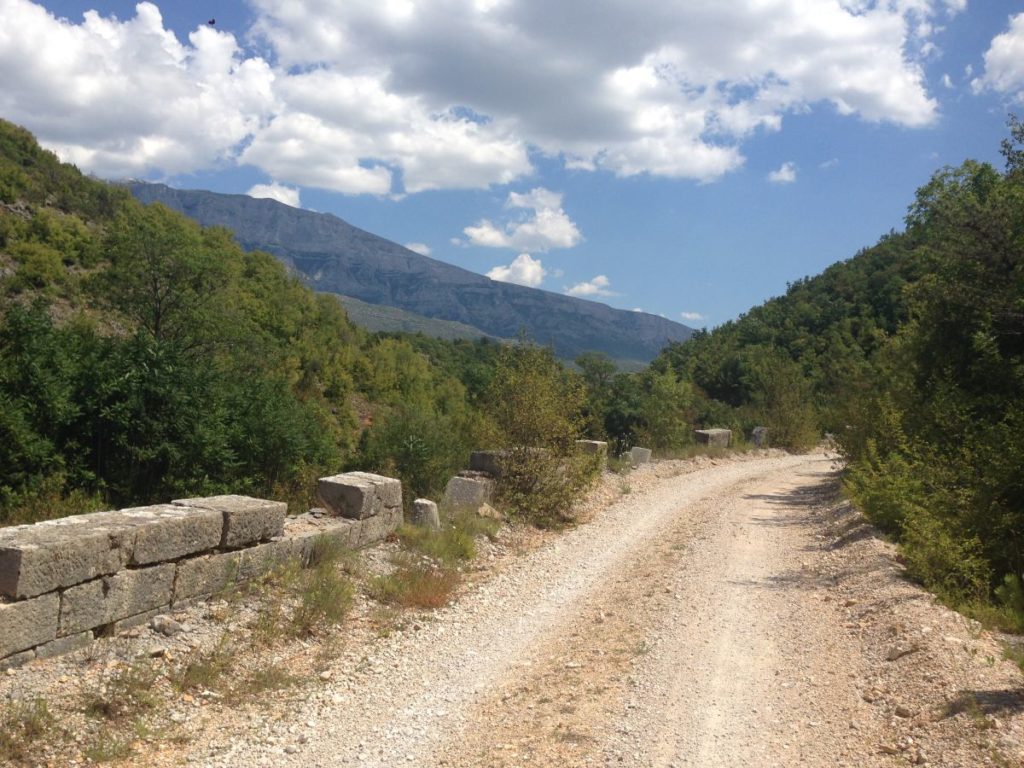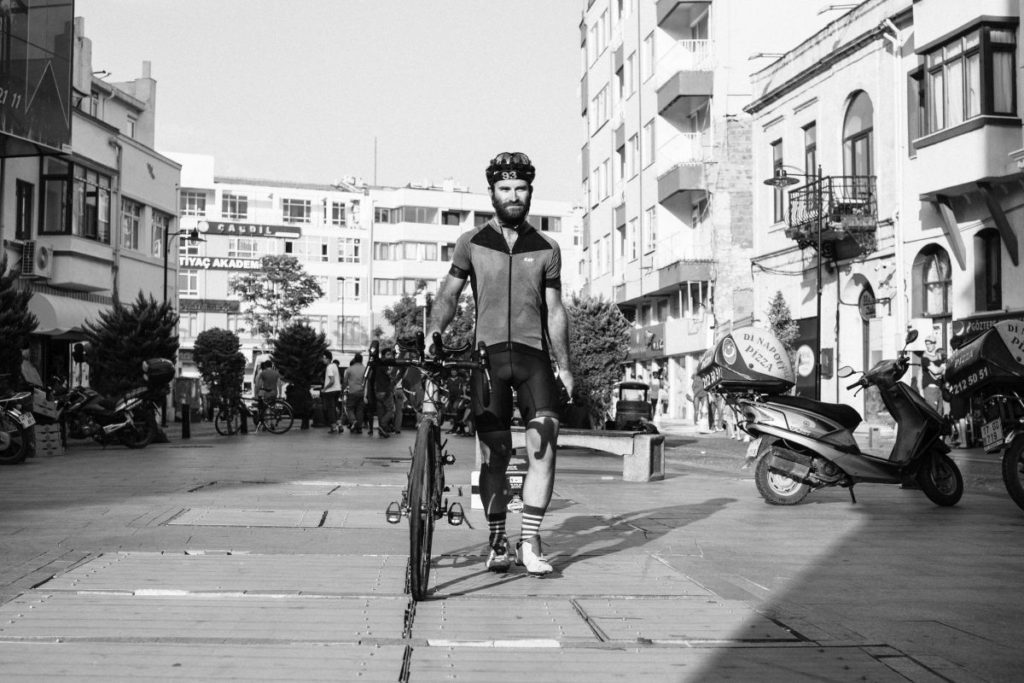The road ahead of Geoffroy Dussault kept climbing. Around each corner, past each false summit, there was more mountain ahead. Dussault was pedalling in the Alps. He was also realizing he wasn’t where he needed to be.
“The night before, I had a bad recovery. I had a bad sleep and hadn’t eaten anything for dinner. The first thing the next morning was a 1,500 m climb to get to the Swiss border,” recalled Dussault thinking back to August 2016 during his first attempt at the Transcontinental Race. “That morning, there was a headwind. It was mean. My body wasn’t there for me that day and I could only do eight hours of biking before I had to stop.”
Dussault was a newcomer to the race known as the TCR. He was regretting his choice of route. For the TCR, the riders don’t follow a set course laid out by organizers. Instead, the participants must construct their own routes from the start at Geraardsbergen, Belgium to the finish last year in Çanakkale, Turkey. (Other editions of the TCR have started in London and finished in Istanbul.) Along the way, they must pass through a handful of checkpoints. In 2016, four checkpoint locations were strung out between the race start and finish. With no set route, there is also no fixed length for the race, but a good result can be earned by finishing in 10 tp 12 days.
Photo: James Robertson
The first two checkpoint locations in the 2016 edition were deliberately placed to bait riders into the Alps. Dussault fell for it. He took a more southern path that was supposed to be a straighter line between checkpoint one (CP1) and two (CP2). He faced mountain passes and valleys, and temperatures that ranged from more than 30 C to near-freezing at higher elevations. ”I had picked the straightest route on Strava, but the straightest line is not always the fastest. It was a good lesson,” said Dussault. More experienced competitors knew that the longer, flatter route to the north was in fact much faster. By skirting the mountains, they remained fresher.
RELATED: The Trans Am Bike Race is a continent-sized challenge
Dussault himself began the event with a lot of energy. The start of the TCR was held at 10 p.m., two days prior to the Alpine struggles, with a ride up the infamous Muur van Geraardsbergen that returned to the Tour of Flanders this year. “As the race started, I felt strong. I was in race mode,” said the rider from Quebec City. He had raced professionally on the Garneau squad, from 2012 to his retirement in 2015. “I said, ‘I’m going to Turkey. Get out of my way!’
“The car filming the whole peloton was just ahead of us. I attacked and got up to the car, but it was not moving fast enough, so I dropped back. Then I said, ‘Forget that,’ and attacked and passed the car and climbed all the way up on my own. After that, I went into my aerobars and rode like a crazy man to CP1.”
Photo: James Robertson
But the effort was costly. About 350 km after his breakaway on the Muur, Dussault realized he was struggling. His knees were troubling him from grinding too hard on the pedals. (He focused on turning a smoother pedal stroke for the rest of the event.) Still, he rode another 160 km before finally stopping, 17 hours after he began. What Dussault had not fully appreciated, but was quickly learning, was that endurance events are not so much about who is the strongest rider on the start line.
Each competitor at the TCR must be entirely self-supported, carrying everything for the race east across Europe to the edge of Asia. Each entrant must balance the luxury offered by carrying more equipment against the slower pace resulting from the added weight. One extremely minimalist-minded rider brought no spare chamois shorts, removing his lone pair only for washroom stops and on the rare occasion he had a chance to wash and dry them before the end of a recovery break. Others took camping gear, in case the need arose.
No drafting is allowed. Rules are strict with respect to how riders must travel to and from places of assistance not on their route. Should a rider need a lift to a bike shop, it’s allowed provided the rider then travels by bike back to where he or she had left the planned route before continuing on. Dussault had opted for a fairly minimalist approach; he carried no camping gear.
Photo: Courtesy Louis Garneau
Dussault arrived in Nevers, France, exhausted at the end of the first day with nowhere to stay. He found a small shed near the road, took out the emergency blanket his girlfriend had given him, and tried to sleep on a hard wooden bench. Later, the route he had laid out in the weeks leading up to the race took him into the Alps, where he spent two days suffering while climbing the passes and dropping down the standings. He had arrived in Europe with ambitions to win. Just two days into the race, he felt broken and was outside the top 30 riders. He had started to question elements of his race plan.
Upon receiving confirmation of his entry the previous December, Dussault began logging a minimum of 400 km a week on his bike. He consulted the rules and prepared his route. He finalized his gear and managed to fit it all into a single bikepacking bag slung under his saddle. As a teenager, he had toured around Quebec carrying all his supplies in a pack on his back. It had weighed 30 lb. He used the same system to cross Canada a year later, covering 8,000 km in 40 days. Those experiences made him confident about his needs for the relatively short TCR.
In the final month before the TCR, Dussault rode 400 km in a single day, snaking through the mountains of the Beauce region in Quebec, and then hopped on his bike the next day for another 100 km to see how his body would react. He was left feeling confident and ready. But even those preparations weren’t enough for a 510-km day that started at night. Dussault calls the 10 p.m. start a deliberate effort by the organizers to force sleep deprivation on the field from the beginning.
Photo: Geoffrey Dussault
While Dussault had chosen a straighter but more difficult route, other riders also made errors in judgement. One rider followed a Strava route that appeared to include a section of mountain bike trail. Instead, he arrived at a hiking trail. Hoisting his bike, the rider started walking. He found a rideable road after a 10-hour, 10-km hike through freezing rain and mud. There are reports of other riders who took a stretch of road signed as having unexploded land mines in the vicinity.
After the Alps, things got better for Dussault. “I recovered enough that I was able to do back-to-back days of 300 km of riding and 6,000 m of climbing,” he said. “When I left the Alps, I turned on the engine and was able to start to come back to the front of the race.” He also worried a little less about his competitors. To see how they were doing, Dussault would have had to stop at Internet cafés to check locator beacons. It was always a choice to trade time in the saddle for information that would do little to change the outcome. Later in the race, Dussault would simply glean what he could at checkpoints and border crossings, focusing on his own performance instead.
Route finding, however, continued to be a source of anxiety. “Just before CP4, I was in Bosnia crossing into Montenegro. I was on this dirt road up over a pass and thought, ‘This is not even a road,’” said Dussault. Nevertheless, he chose to press on farther. “At some points, you just don’t know where you are at all. You must be confident in the route you planned.”
Photo: James Robertson
Benefiting from flatter land, and being more careful to ensure good recovery periods, Dussault climbed up to sixth place out of 300 total entrants by the time he arrived at CP4, in Žabljak, Montenegro. Riding in the city had been challenging; twice Dussault had to dodge out of the way of cars, narrowly avoiding collision. But his mood shifted when he saw a stranger at the side of the road. A man stood waving and cheering, holding two chocolate bars in an outstretched hand, encouraging Dussault to come grab them. “It was like a feed zone. I didn’t even stop,” said Dussault. “I was going almost 45 km/h, and snatched the bars and then turned my head and just yelled ‘Waaaah!’ in a big cry of joy and waved and smiled at the guy.”
Somewhere in Montenegro, Dussault noticed the sidewall on his front tire was starting to give out. With less than 1,000 km remaining, he hoped it would make the trip. Dussault kept going. By the time he reached Turkey, and with 125 km to the finish, the tire failed. Dussault had one spare tube, still brand new in the wrapper. But the tube had a puncture and was of no use. It was a Sunday in rural Turkey. There was nowhere to buy a new tire or tube.
Even though the finish was an easy ride away, Dussault was forced to stay put. He arranged for a ride into a town the next morning to find a bicycle shop. On the Monday morning, he and his front wheel hopped into a car with a local to find a shop. The store had no tires, so Dussault bought three tubes and managed a rudimentary repair. He hopped back in the car to return to his bike with his wheel. He fitted the wheel into the fork and took off for the finish. The repair held up for 100 km. Dussault was forced to complete the final 25 km on a flat. He had lost 17 hours as a result, plus additional time penalties for returning to his route by car.
“People were watching the live tracking, wondering what was happening because I was so close to the finish, but not moving. I stopped around 7 p.m. and didn’t start again until 11 a.m. the next day,” said Dussault, who had been unable to communicate with anyone, including race organizers, to let them know what was happening.
Photo: James Robertson
When all the results were in, and penalties calculated, Dussault had finished seventh overall. The whole event left him with mixed feelings. He had done very well, but had also seen all the places he lost time as a result of poor planning and inexperience. The TCR holds two facets. The competition demands a fast pace, minimal stops, but the terrain covered begs riders to consider stopping to indulge in the beauty through which they race. Dussault rode past tourists sunbathing, swimming and drinking on beaches in Croatia. He wanted to stop, but his racer’s instinct pushed him onward.
“Once you reach the end of the race, it feels like it has happened so fast that you want to keep going on this big adventure,” said Dussault.
In fact, Dussault has chosen to continue the adventure. He’s registered for the 2017 edition of the race, which starts Friday, to apply all he learned in 2016. Rather than talking about whether he can win or not, he’s fine-tuning his route finding, using software that does a better analysis of elevation. He’s plotted his own pace against grades so he can select a route on which he can perform better. He’s also working to improve his efficiency during each riding day and minimize the time spent on stops for fuelling.
“I don’t think this is an event I will keep doing, over and over,” said Dussault. “There are too many other adventures in the world. And my girlfriend and I are thinking about starting a family. That’s perhaps a different kind of adventure.”
